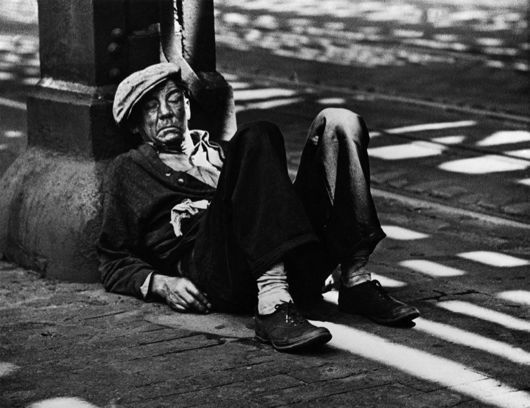If you were down and out on the Bowery in the 1940s or 1950s, you wouldn’t want to earn the reputation as a “toes-up mokus” or aggressive “pinker” because you just might “catch some heat” from the “bulls” – or worse – you might be ostracized by your contemporaries and “outed” publicly in the Bowery Blue Book.
The legendary Bowery began hosting a notable homeless population as early as the 1870s. Many struggling Civil War veterans migrated towards major cities like New York in search of occupational prospects, only to find competition in a workforce already saturated with incoming immigrants and thousands of other Americans attracted to urban areas for similar opportunities.
Thanks to several charitable organizations, those who could not catch a break in our city still had the opportunity to live a somewhat respectable life while pursuing a career. The YMCA opened a branch on the Bowery in 1873 and the Bowery Mission opened its doors in 1879. In 1890, in response to steadily growing demand, the Salvation Army opened four locations on the avenue within less than a mile of each other.
By 1900, there were over 100 lodging houses and missions lining the Bowery and by the height of the Great Depression, an estimated 75,000 people took refuge on what was referred to as a “mile of hell” between East 14th Street and Chatham Square.
Though the Bowery’s population dwindled to fewer than 14,000 after WWII as welfare programs, public housing and veterans’ benefits became more readily available, a problem arose; old-timers disapproved of a new breed of characters filtering into their sanctuary, whom some felt disregarded the unwritten, yet very sacred rules and established hierarchy of “Hobodom” which was cultivated on the Bowery for over half of a century.
One man leading the charge was St. Louis native Harry Baronian, an attractive, well-spoken Armenian American who spent 15 years “on the bum” after moving to the Big Apple just as the Depression hit.
By the early 1940s, Baronian secured a part time gig writing articles for the Hobo News, a bi-weekly circular which was established in 1936 and distributed amongst the denizens of the east side. Here, the imaginative journalist suggested a tongue-in-cheek society column, which spotlighted the famous and infamous of “Hobohemia.” The column was a hit.
After a falling out with the Hobo News, Baronian set out to start his own newspaper and in October 1945, a press conference of sorts was held at a saloon called Joe’s Juke Box on 47th Street to announce the launch of Bowery News.

Addressing a room packed with a variety of Bowery characters, Baronian proclaimed, “We’ve got an important job to do, so let’s get serious. We got to do something to preserve the honest character of the Bowery. Some folks we know down there are acting as bad as if they lived in café society and this paper is going to tell ‘em about it.”[1]
In attendance was Bozo, the “hobo poet,” who agreed, stating, “Fellows, the Bowery News has got to make its readers honest bums again… I even saw one guy wearing pajamas to bed in a flop house.”
A week after that meeting, the first 12-page Bowery News hit the streets. Calling itself “The Voice of Society’s Basement,” The tabloid quickly gained a following beyond Bowery circles, as outsiders developed a peculiar curiosity with street life and unfamiliar local lingo such as “mokus” (a drunk), “scratch house” (flop house), “toes up” (nuisance), “pling” (panhandle), “bull” (cop), “stiff” (laborer), “gandy dancer” (railroad worker), and “pearl diver” (dishwasher).

By 1948, Bowery News took over as the premier source for news and information about life from within the city’s underbelly, and Hobo News went under.
The enterprising Harry Baronian hatched a plan to broaden his original society column idea by mocking the well respected “Uptown Blue Book,” a social register which profiled Manhattan’s most accomplished citizenry. Baronian’s offering, the “Bowery Blue Book,” went on to run for 72 issues over the next decade and a half and helped introduce the world to some of the most colorful and eccentric personalities the Bowery had to offer.
The two-page paper cheered success stories and jeered unwritten-rule breakers. Baronian and his staff of insiders pulled no punches when “outing” those who went against the traditional Bowery Bum code of ethics. For example, in 1950, “Buffalo John” was outed for stealing a dental bridge from a sleeping companion. “Home Relief Dick” was outed for looking down on his friends whenever he came into a few dollars. “Crown Prince Bozo” was shamed for “conduct unbecoming a hobo” and “Frisco John” for verbally abusing people who turned him down for a handout.
Some others outed throughout the years include:
- Joe Gould (a Harvard graduate) who “helped save water by not showering” (he stunk).
- Union Square Pete, “One day he’s a socialist, another day he’s a wobbly, then he’s an existentialist.”
- Toes-Up Wally, who was a general nuisance.
- Freddie the Guzzler, who, when offered a sip from a jug, sucked out half the contents.
- Hester Street John, who stole a drunk pal’s shoes.
- Dick the Mission Stiff, for feigning recovery in exchange for a mission meal.
- Joe the Mokus, who had a habit of throwing empty bottles out of flophouse windows.
Some of the success stories published in the Bowery Blue Book included our friend Bozo the Hobo Poet, who was cheered in 1948 for graduating from the Bowery to become a pearl diver in a grandy dancer camp. That same year “Hobo King” Ben Benson, who at the age of 65 traveled from New York City to Los Angeles without a dime, was celebrated as an example of “American ingenuity.”
In 1958, Bowery News expanded into an eight-page spread, however a letter to the editor that same year was foretelling of Skid Row’s fate; The author claimed that the beatniks were providing unfair competition to panhandlers and even complained of the subculture’s “screwball beards” and “screwball clothes.”
By the 1960s it was clear that the days of the traditional Bowery Bum were all but over. Beyond the influx of suburban artists and students seeking cheap rent, the gritty saloons, barber colleges, pawn shops, scratch houses and greasy spoon diners—which supported the Bowery’s hobo culture for several decades—were slowly being replaced by lighting stores and Chinese wholesalers.
When Bowery News and Bowery Blue Book folded in 1963, over 7,000 transients overflowed from the 20 or so flophouses which remained on the Bowery. By the end of the 1960s a growing city-wide heroin epidemic, among other motivators, began attracting a more dangerous and unpredictable element to the district. The Bowery was no longer considered to be a safehaven for the dizzy drunk or naive street corner philosopher and the tramp life—which was almost romanticized in prior decades—had long faded by the 1970s.
Harry Baronian passed away penniless in New York City on August 4, 1965 at only 54 years old. Sadly, he never got to fulfill a dream of his, which he announced to the crowd during the Bowery News press conference at Joe’s Juke Box in 1945:
“This paper is going to go over. I’ve been away from home for 15 years. I’m going back to the middle west a success… I’m going home with my shoes polished.”
[Article originally written for the LoDown: http://www.thelodownny.com/leslog/2013/04/les-history-a-look-back-at-the-bowery-blue-book.html ]

Eric is a 4th generation Lower East Sider, professional NYC history author, movie & TV consultant, and founder of Lower East Side History Project.
